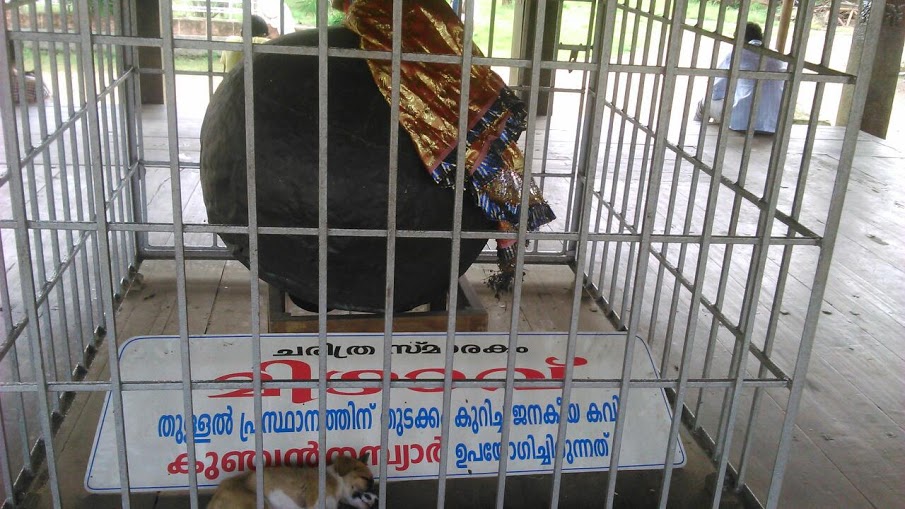Ambalapuzha Sri Krishna temple enjoys an important place in the culture and history of the state of Kerala. It ranks alongside Guruvayoor and Trichambaram Krishna temples in terms of religious significance and attracts hundreds of thousands of devotees each year. The temple is built in the Kerala style of temple architecture and enshrines Lord Krishna as Lord 'Parthasarathy'. The Lord is also referred to as 'Gopala Krishna' by some devotees. The inner walls of the 'Chuttambalam', a structure constructed around the Sanctum Sanctorum of traditional Keralite temples, are home to beautiful paintings of the ten incarnations of Lord Vishnu – The 'Dasavathaaram.' The temple is also associated with 'Ottanbullal', a traditional art form originally designed by Kunchan Nambiar, a poet, and was first performed in the temple premises. The town of Ambalapuzha played a significant part in the political history of the state with it being the headquarters of the erstwhile Chembakasseri kingdom. The 'Palpayasam', a deliciously sweet milk porridge that is offered at the temple is renowned all over the country.
History
The town was under the Chembakasseri rulers from the 14th to the 18th century CE. The temple was built between 1615 -1630 CE by Pooradam Thirunal  Devanarayanan, the Chembakasseri ruler. However, worship services might have started much earlier as the Lord's image was consecrated much earlier, in the fourteenth century CE.
Devanarayanan, the Chembakasseri ruler. However, worship services might have started much earlier as the Lord's image was consecrated much earlier, in the fourteenth century CE.
Legends
Legend has it that once the founding ruler of Chembakasseri kingdom, King Devanarayanan, and the great Villwamangalathu Swamiyar were travelling in a boat. Suddenly, Villwamangalathu Swamiyar heard some soothing flute music emanating from a nearby source. Wanting to trace out the source of this enchanting music, Swamiyar asked for the boat to make a halt at the shore. He went in search of the music and to his astonishment saw Lord Krishna Himself, sitting on the branch of a tree and playing the flute. Swamiyar, an ardent devotee of the Lord, couldn't believe his eyes. He along with the King circumambulated the tree singing the glory of the Lord. Swamiyar asked the king to erect a temple at this place in honor of the event. The king obliged and as a first step bought the land from Ambanattu Panicker, an Ezhava chief, who was the then owner of the property. It however was a submerged land and the King had to arrange for a lot of soil filling before he could erect the temple. The King was in a shock as couldn't go ahead with the consecration of the image on the planned day as Puthumana Namboothiri, the priest invited to assist the head priest Kudamaloor Kadiyakol Namboothiri in the consecration, raised an objection that the idol was impure and not to be consecrated. He proved his argument by knocking on the side of the idol with a Pooja vessel. Out came a frog and some water from the abdomen part of the image and shocked everybody present at the event. Parayil Menon, a minister of the king, offered to bring another idol of the Lord. The idol at Kurichi was on his mind but the king was apprehensive as he wasn't on good terms with Thekkumkur Raja, under whose control was Kurichi. Nevertheless the minister convinced the king, started for Kurichi with some soldiers, convinced Valiyamadathil Panicker, the temple incharge at Kurichi, and finally brought the image to Ambalapuzha. The consecration ceremony that followed was welcomed by a huge number of devotees who reached Ambalapuzha in several boats. The star of the day is 'Moolam' and this led to the Moolam Valam Kali celebrations that include the popular boat race.
The legend of the king borrowing paddy from a Brahmin to feed his subjects during a famine led to the popular 'palpayasam' as the temple offering. According to the legend, the king couldn't repay the loan to the Brahmin. But the Brahmin was very demanding and stood at the entrance of the temple to stop the king from offering his worship to Lord Krishna. The king deeply disturbed by the situation asked his minister Parayil Menon for a solution. The minister summoned all the subjects and asked them to contribute whatever paddy that they can and asked them to bring that paddy to the temple courtyard.
That same day the 'Annakkottil' of the temple was filled with paddy and the Brahmin was ordered to take away all the stock towards his loan repayment before the noon pooja. However, none of the locals helped the Brahmin in clearing the stock. The Brahmin was very frustrated with this but was able to see through the situation and acknowledged the righteousness of the king, and offered the entire paddy to the Lord, and asked the revenue to be used for the 'Palpayasam'. Thus from that day the tradition continues and the special milk porridge offering has become popular among the Lord's devotees the world over.
Festivals
The annual festival, the Thiruvulasavam, is celebrated in the month of Meenam (March/April). The celebrations include various cultural programs especially the popular Velakali, an ancient dance form exhibiting martial feasts. A grand feast is organized on the ninth day of this festival and it is believed that Lord Krishna attends the feast on this day. Thousands of devotees from all across take part in these celebrations.
Ashtamirhini in the month of Chingam (August/September), Panthradu Kalabham in the month of Makaram (January/February), Navaratri in the month of Kanni (September/October) are other popular festivals at the temple.
The Baghavatha Sapthaham and Pallippana are celebrated once every twelve years while the Vijayabali is celebrated once every 144 years.
Places of Interest
The Mullakkal Rajarajeswari temple at Allapuzha, Sri Nagaraja temple at Mannarsaala near Haripad, Kottamkulangara Mahavishnu and Devi temple and Chettikulangara Bhagavathi temple.
Accommodation
Accommodation is available in the form a Devaswom administered Satram. In addition, there are some private facilities in the town.